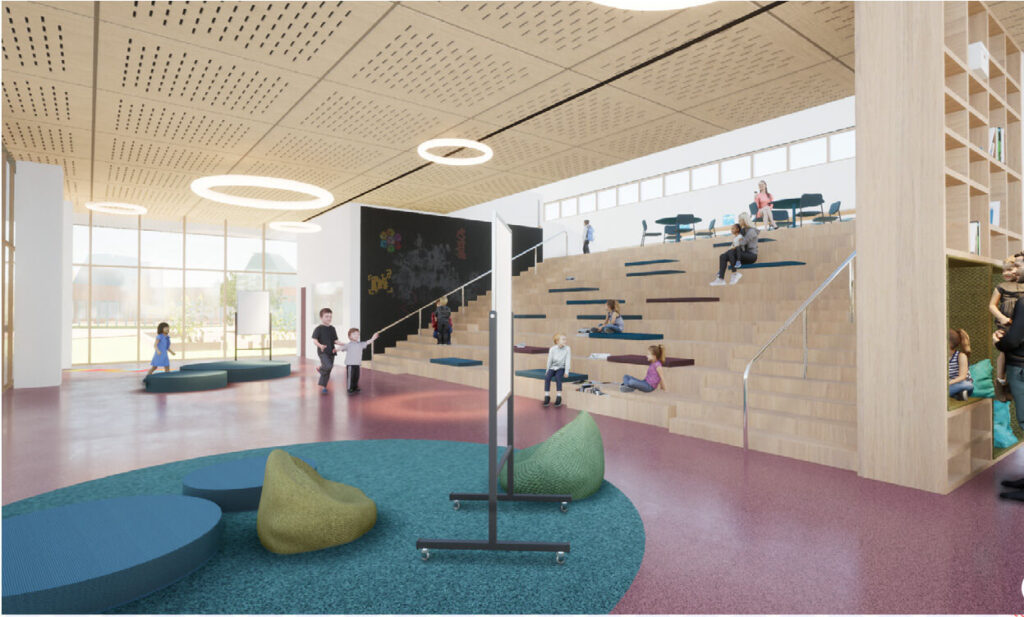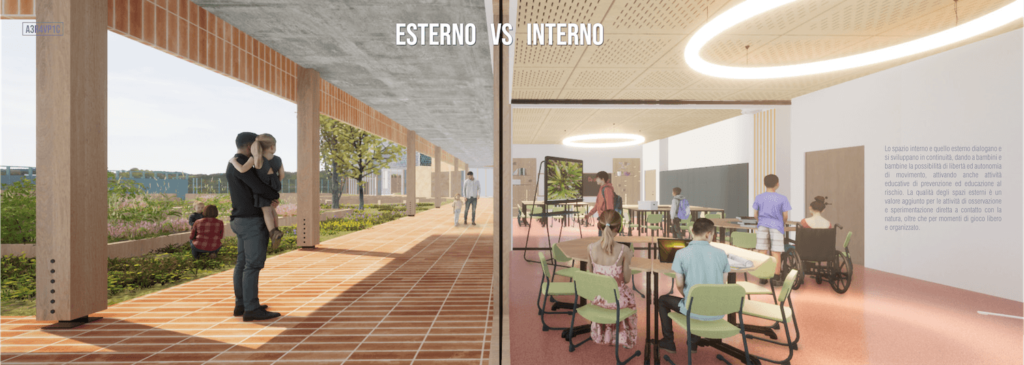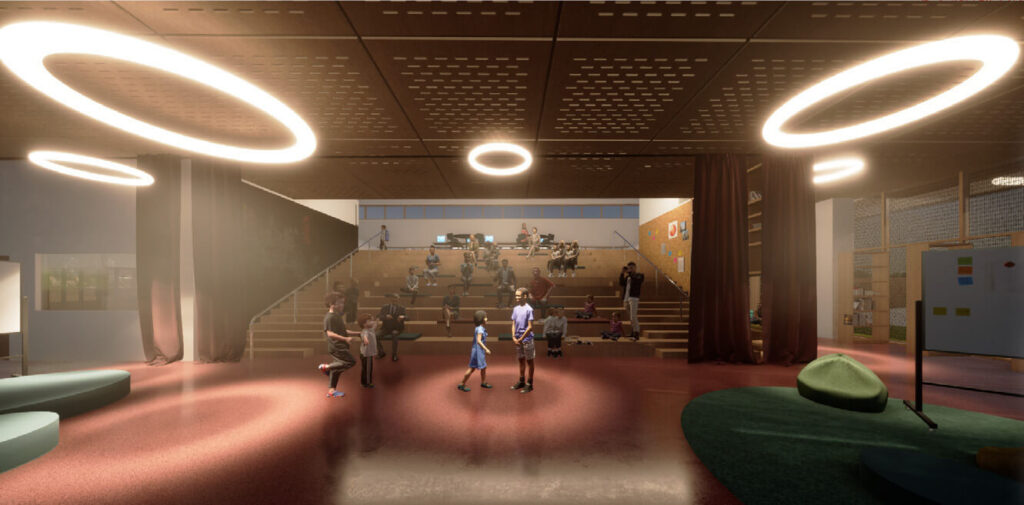The project proposal envisages the demolition of the existing school building and the reconstruction in situ of a new school complex that, in addition to housing Adrano’s kindergarten and primary school, can also become a place for children to play and meet outside school hours. The spaces are designed to ensure well-being and maximum inclusiveness, not only in terms of accessibility but also in terms of adaptability to the multiple functions of play, movement and care, thus stimulating a sense of community at all ages. The library, which is also used as a multi-purpose space and/or auditorium, the gymnasium and the internal courtyard equipped with sports fields, can be easily used during extracurricular hours for cultural, sports and recreational activities, without interfering with the space dedicated to classrooms. The library, in particular, also spreads into the connective spaces of the primary school with the placement of shelves and informal seating that offer surprising stimuli for enjoyment, thus generating a habit that will be the basis of the future relationship with books. The project is configured in such a way that all the children can enjoy it in an autonomous and self-regulated manner, thinking of safety also as risk education, therefore as a pedagogical value before being a prescriptive constraint.
Our Intervention
The building is generated by the intersection of three elements: the classroom, the cluster and the shape of the lot, marginalised in relation to a dense and disorganised urban fabric. The Wind Towers, born from the need to bring natural light and ventilation, become recognisable elements in the landscape and combine tradition and technological innovation.
The school is articulated around a courtyard whose main atrium overlooks the striking panorama to the west, over the Simeto Valley. The Wind Towers, the vertical distribution bodies and the common spaces-canteen, gymnasium, library-emerge from the body clad in earthenware that contains the classrooms. In this play of volumes, the gymnasium and library constitute the “threshold” with the city, defining the main entrances to the school, also from a symbolic point of view.
The façades are clad with local materials to preserve the colours of indigenous architecture and limit the environmental impact of transport.
The teaching space is divided into clusters made up of three units dedicated to classes, or laboratories, and a buffer space, i.e. an area common to a cluster of three classrooms, useful for transversal activities. The clusters are connected by an internal distribution and an external one consisting of patios and walkways that become a kind of extension of the classroom for teaching activities. The canteen is placed between the nursery and primary school clusters with differentiated access. The outdoor and covered space, adjacent to the classrooms, is to be considered as a true open-air classroom that extends the surface area of the classroom particularly in good weather.
The courtyard around which the building is articulated responds to the need to have large multifunctional areas, for sports, environmental education (the vegetable gardens intended for citizenship) and play, both free and structured (sandpit, geodesic dome and spider’s web of ropes). The
greenery extends and inserts itself into the building’s internal space with patios and small courtyards
In compliance with the NZEB requirement, the building aims at passive climate control with solutions that reduce energy needs, such as the use of shading façade elements with low thermal capacity, of window and door frames and glazing with high energy performance and low emissivity, but also through the implementation of an integrated photovoltaic system for the production of electricity from renewable sources and the adoption of a high reflectance and low transmittance roofing. The lighting system is designed with LED lighting fixtures and controlled by sensors capable of maximising the use of natural light and modulating artificial light at different times of the day according to pre-set scenarios, differing in terms of function of use and level of occupation of the rooms. Rainfall, from roofs and walkways, will be collected, filtered and reused for less valuable uses (irrigation and dual-compartment toilet cisterns). In addition, at least 70 per cent by weight of materials from demolition will be sent to reuse, recovery and recycling operations.
Technical Pills
Born out of the need to bring natural light and ventilation, the Wind Towers combine tradition and technological innovation in order to maximise contributions from renewable sources, through an orientation designed to take advantage of the prevailing winds and zenithal light. The all-air air-conditioning system is designed to favour the washing of the air and minimise the risk of “in door” contamination as much as possible with the help of appropriate filtration systems. The inclusion of appropriately sized heat recovery units and the use of high-efficiency fans inside the Air Handling Units, also contributes to a considerable reduction in energy consumption. The adoption of an XLAM structure guarantees greater seismic safety, compared to other materials, due to the greater lightness of the resistant mass and the greater capacity to dissipate seismic energy. The efficiency of the mechanical systems is increased through the use of class A BAC (Building Automation and Control) systems in accordance with the EN15232 standard which, in concert with TBM (Technical Building Management) software, make it possible to rationalise the use of energy resources to the building’s actual needs.
Awards
Fourth Place – International Design Competition
Object of intervention
Demolition and reconstruction of the Don Antonino La Mela school complex
Performances – Stancanelli Russo Associati
Two-stage design competition. Drafting the proposal 4th Classified
Client
Municipality of Adrano
Partners
AREAPROGETTI srl
Year
2022
Design technology
Building Information Modeling (BIM)








